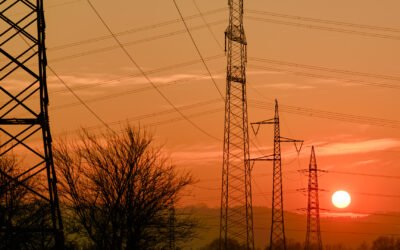• The environmental impact of maritime traffic is examined, focusing on the potential of shore-to-ship power systems to drive sustainability in the industry.
• The disparity is unveiled by analyzing vessel traffic data and onshore power supply systems, highlighting the need for accelerated action to bridge the gap.
• The progress and initiatives of countries like the Netherlands, Germany, Norway, Spain, and Italy in adopting shore-to-ship power, paving the way for a greener and more sustainable maritime sector.
As the maritime industry endeavors to achieve a cleaner and more sustainable future, the environmental impact of maritime traffic has emerged as a central concern. These immense vessels, serving as the backbone of global trade, traverse the vast expanses of the oceans. However, beneath their awe-inspiring presence lies a significant issue that demands our attention. These ships leave in their wake a trail of emissions that pollute the air we breathe and undermine the overall environmental well-being.
Amidst this challenge, a glimmer of hope emerges in the form of shore-to-ship power. This innovative concept seeks to revolutionize port operations and redefine how ships obtain their power. In this article, we will delve into the realms of vessel traffic data and onshore power supply systems, unraveling the intricate relationship between these two domains. Through meticulous data analysis and exploration of port activities, we aim to shed light on the interconnectedness between vessel traffic intensity and the availability of onshore power supply systems.

Figure 1: Charting Marine Activity: Major European Countries and their OPS Systems Deployment
Source: PTR Inc.
The table in Figure 1 illustrates the significant volume of maritime activities occurring in ports across the Netherlands, Germany, Spain, Italy, and Norway.
Examining Figure 1 paints a compelling portrayal: the volume of vessel traffic seems to significantly outweigh the count of shore power connections, pointing to a slower rate of adoption for onshore power supply (OPS) systems. This suggests that despite the environmental advantages of OPS, the transition to this cleaner technology has been gradual. Nonetheless, within this observation, a ray of hope emerges. The European Union (EU) and the International Maritime Organization (IMO) have started to implement increasingly stringent maritime regulations, pushing the industry towards a more sustainable trajectory.
In an effort to combat greenhouse gas (GHG) emissions, the maritime industry is embarking on a progressive journey. By the year 2030, containerships and passenger ships at major EU ports are mandated to utilize on shore power supply, a move aimed at reducing emissions and promoting sustainability. Moreover, by 2034, ships’ fuel mix must incorporate at least 2% of specific renewable fuels, further bolstering the industry’s commitment to greener practices. These collective measures signify a significant step forward in the quest for a more environmentally conscious and responsible maritime sector. The noticeable upward trend signals a growing recognition of the importance of reducing emissions from vessels at berth and aligning maritime operations with global sustainability goals. While the progress may have been relatively slow initially, the evolving regulatory landscape is paving the way for a future where OPS becomes the norm rather than the exception.
Most ports worldwide aspire to achieve carbon neutrality by 2050. A considerable number of these ports have already committed to implementing shore power systems by 2028 whenever feasible. Notable ports, such as those in the North Sea region, Los Angeles, Montreal, and major Japanese ports, are among those who have signed such declarations. Cruise and container vessels are the main focus of regulations set by most ports, and the European Union (EU) will begin imposing taxes on vessels through the EU Emission Trading System (ETS) starting from the following year. These measures represent a significant effort to address emissions and promote sustainable practices within the maritime industry.
The Netherlands
An in-depth analysis of vessel traffic data reveals intriguing insights into the vibrant maritime activities occurring in various ports around the world. Among the regions capturing the spotlight, the Netherlands emerges as a powerhouse of maritime commerce, with its ports witnessing the highest constant influx of ships, fueling global trade.
The port of Rotterdam is accountable for nearly 14 million tonnes of CO2 emissions annually, making it equivalent to Europe’s fifth largest industrial polluter, the Weisweiler coal power plant in Germany. However, the port authority has also set ambitious targets for the installation of shore-to-ship power systems. The Municipality of Rotterdam and the Port of Rotterdam Authority are jointly implementing shore-based power for sea-going vessels. By 2030, they aim to have a significant number of vessels using shore power while moored at the port’s quays, reducing air pollution and carbon footprint. Over the next five years, they will initiate projects to accelerate and expand the adoption of shore-based power. The plan represents a major step towards sustainability in the port, improving air quality and living conditions for residents and surrounding nature areas.
The partners’ shore-based strategy has three pillars:
1. Fitting public quays in built-up areas with power points, aiming for 90% usage by 2030.
2. Creating new power capacity for specific vessel types to reach 90% utilization by 2030.
3. Focusing on innovations for challenging vessel categories. The plan requires an estimated $137 million investment, with around $55 million from public funding.

Figure 2: Netherlands’s Busiest Ports and their OPS Systems Count
Source: PTR Inc.
Germany
Germany’s economy is closely intertwined with international trade, making maritime traffic a crucial aspect. Given its strong emphasis on exporting goods, the smooth functioning of maritime activities becomes pivotal for supporting the country’s GDP. Germany’s ports and maritime infrastructure play a vital role as key trade hubs; however, this also means they contribute significantly to climate pollution.
Striking a balance between economic prosperity and environmental responsibility is crucial as Germany navigates the challenges of maintaining its trade dominance while actively addressing climate pollution. German port initiatives include an onshore power facility for cruise ships under construction at Rostock-Warnemunde; ten facilities to be built at Hamburg for onshore power; plans for eight facilities for merchant ships at Bremerhaven.

Figure 3: Germany’s Busiest Ports and their OPS Systems Count
Source: PTR Inc.
Norway
Norway has consistently been a pioneer in the installation of shore power systems. The country’s steadfast dedication to maritime decarbonization, supported by state funding initiatives such as Enova, has led to remarkable achievements in implementing shore power installations. Enova, the Norwegian government’s entity, is preparing to finance five new shore power projects with an investment of approximately $3.4 million. This funding stems from Enova’s 13th call for investment support in shore power initiatives. Since 2016, Enova has already funded 119 shore power projects, amounting to over $85 million.
Norway’s resolute focus on reducing emissions and embracing sustainability has positioned it as a global leader in adopting onshore power supply. The data depicted in the graphs further reinforces Norway’s exceptional status, showcasing a noteworthy balance between vessel traffic intensity and the adoption of shore power systems.

Figure 4: Norway’s Busiest Ports and their OPS Systems Count
Source: PTR Inc.
Spain
Although Spain has had significant vessel traffic, it has historically been slow in adopting shore power systems. Nevertheless, the situation is changing as Spain gains momentum with the implementation of its OPS Master Plan. Through focused efforts and dedication, the country is bridging the gap and recognizing the potential of onshore power supply. The unfolding of the OPS Master Plan promises a remarkable transformation for Spain, with reduced emissions and a path towards a more environmentally friendly future.
In addition to the OPS Master Plan, Spanish ports are actively pursuing the installation of shore power infrastructure, with the port of Barcelona serving as a prime example.
The Port of Barcelona has committed to investing $123 million in its Nexigen project, aiming to decarbonize port operations and enhance air quality. A significant portion, $100 million of the funding, will be dedicated to implementing onshore power supply (OPS) systems. These OPS systems will enable ships to connect to the general electricity grid during berthing, utilizing 100% renewable clean energy.

Figure 5: Spain’s Busiest Ports and their OPS Systems Count
Source: PTR Inc.
Italy
Despite the significant volume of vessel traffic in Italy, the adoption of shore power systems has been relatively slower. However, a notable shift is now underway as the country takes proactive measures to embrace onshore power supply (OPS) installations. In a groundbreaking move, Italy has allocated a staggering $770 million for port electrification projects through its National Recovery and Resilience Plan. This remarkable commitment underscores Italy’s dedication to sustainability and signals a pivotal turning point in the country’s maritime sector.

Figure 6: Italy’s Busiest Ports and their OPS Systems Count
Source: PTR Inc.
Looking Forward
The prospect of shore-to-ship power is filled with hope and promise. Although there currently exist disparities between vessel traffic and the adoption of onshore power supply systems, there are promising indications of progress. As environmental awareness continues to grow and stricter maritime regulations take effect, the push for change gains momentum. The industry is witnessing a notable shift towards embracing cleaner technologies and practices, with a rising trend in the implementation of onshore power supply systems expected. The key to moving forward lies in maintaining collaboration between stakeholders, investing in research and development, and establishing supportive policies and incentives.
By harnessing the transformative potential of shore-to-ship power, we can navigate towards a future in which the maritime industry flourishes sustainably, operating with enhanced cleanliness and reduced environmental impact.
Shore to Ship Service Overview
The research presented in this article is from PTR's Shore to Ship service. For information about this service please submit a request shown below.
Contact Sales:
Europe
+49-89-12250950
Americas
+1 408-604-0522
Japan
+81-80-7808-1378
GCC/Rest of APAC
+971-58-1602441
More about our:
Shore to Ship Power Market Research
Recent Insights
US Elections: Consequences of a Second Trump Presidency for Energy Sector
The US is making strides to move away from fossil fuels and eventually decarbonize the energy sector. The White House aims to achieve 80% renewable...
Sustainability Across Sectors: Highlights from GreenTech Festival 2024
Recently, I had the privilege to attend and present at the Greentech Festival, an excellent event in the realm of sustainability. This influential...
US and EU Strategies in Smart Buildings
Download Service Overview The EU and USA aim to decarbonize their building sectors to meet emission reduction targets. Initiatives like the Home...


